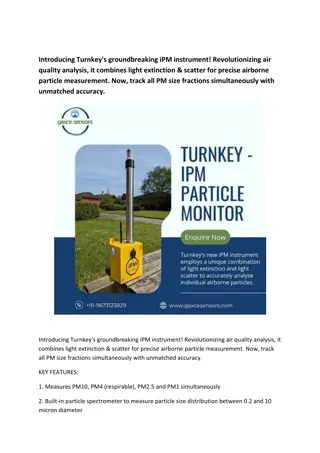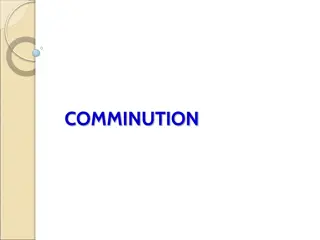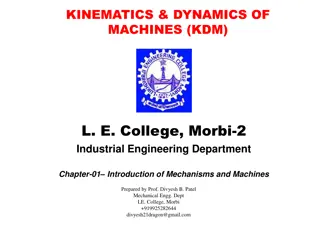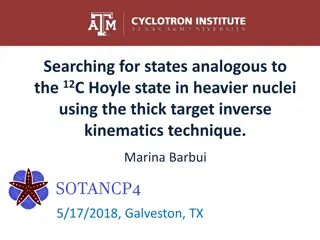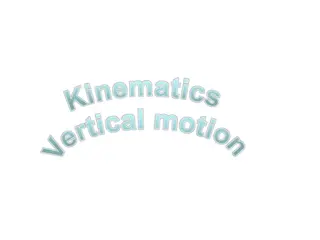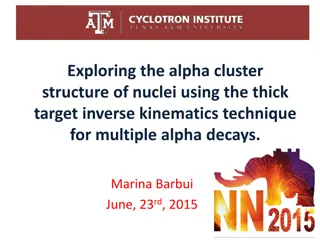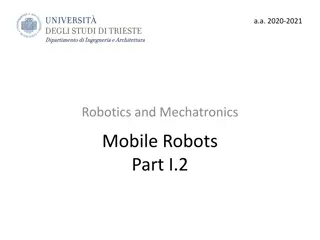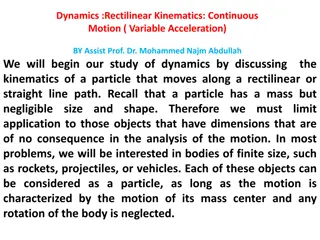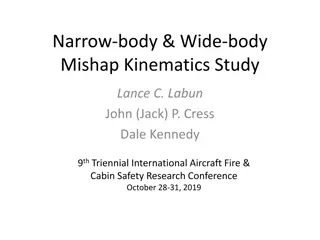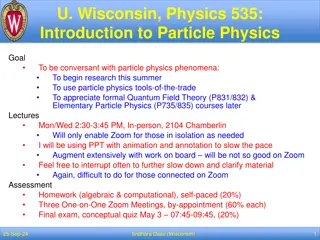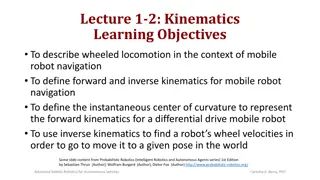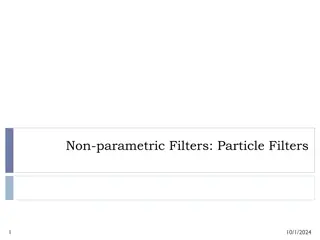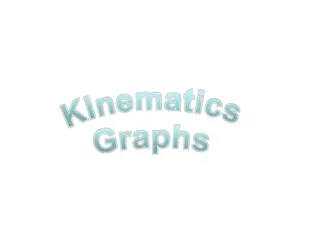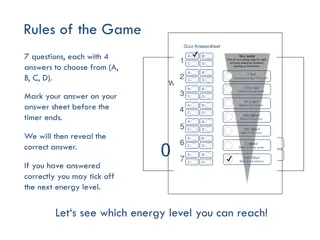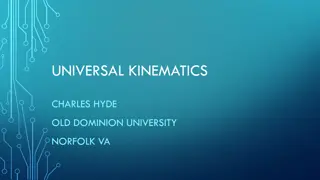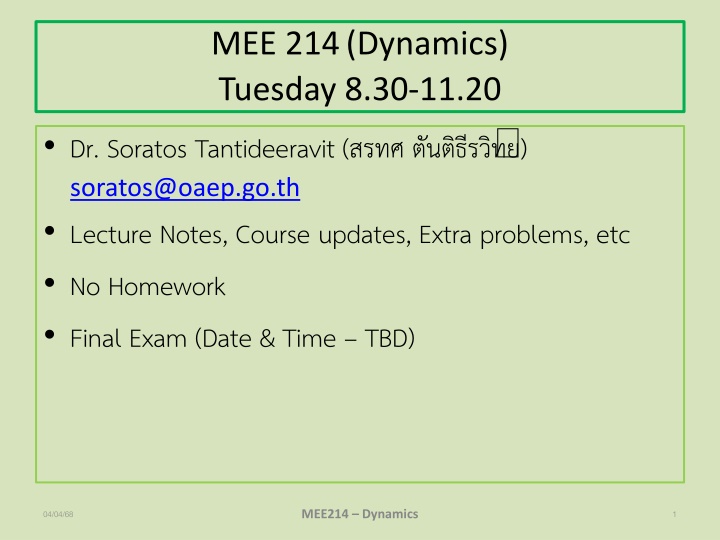
MEE214 Dynamics Course Overview and Kinematics Study
Explore the course outline for MEE214 Dynamics focusing on kinematics of particles, rectilinear and curvilinear motion, kinetics, forces, acceleration, work, energy, impulse, momentum, and systems of particles. Dive into concepts of position, velocity, acceleration, displacement, and more through lectures and additional resources provided by Dr. Soratos Tantideeravit. No homework assigned; preparing for the final exam.
Download Presentation

Please find below an Image/Link to download the presentation.
The content on the website is provided AS IS for your information and personal use only. It may not be sold, licensed, or shared on other websites without obtaining consent from the author. If you encounter any issues during the download, it is possible that the publisher has removed the file from their server.
You are allowed to download the files provided on this website for personal or commercial use, subject to the condition that they are used lawfully. All files are the property of their respective owners.
The content on the website is provided AS IS for your information and personal use only. It may not be sold, licensed, or shared on other websites without obtaining consent from the author.
E N D
Presentation Transcript
MEE 214(Dynamics) Tuesday 8.30-11.20 Dr. Soratos Tantideeravit ( ) soratos@oaep.go.th Lecture Notes, Course updates, Extra problems, etc No Homework Final Exam (Date & Time TBD) 04/04/68 1 MEE214 Dynamics
Course Overview Kinematics of a Particle Rectilinear and Curvilinear Motion Kinetics of a Particle Force and Acceleration Work and Energy Impulse and Momentum Kinetics of a System of Particles 04/04/68 2 MEE214 Dynamics
Introduction to Dynamics Statics Engineering Mechanics Dynamics Kinematics Kinetics 04/04/68 3 MEE214 Dynamics
Objectives Concepts of position, displacement, velocity, and acceleration. Particle motion along a straight line Particle motion along a curved path using different coordinate systems. Analysis of dependent motion of two particles. Principles of relative motion of two particles using translating axes. 04/04/68 5 MEE214 Dynamics
Rectilinear Kinematics Origin Define a fixed point in space Position Defined by a position vector r or an algebraic scalar s 04/04/68 6 MEE214 Dynamics
Rectilinear Kinematics Displacement Change in position s Velocity s = vavg ds t v = dt 04/04/68 7 MEE214 Dynamics
Rectilinear Kinematics Acceleration v = aavg t 2 dv d s = = a 2 dt dt = a ds v dv 04/04/68 8 MEE214 Dynamics
Constant Acceleration a = c a = + v v a t 0 c 1 = + + 2 s s v t a t 0 0 c 2 ( = + 2 2 0 2 ) v v a s s 0 c 04/04/68 9 MEE214 Dynamics
Problem 12-31 The acceleration of a particle along a straight line is defined by a=(2t-9) m/s2, where t is in seconds. At t=0, s=1 m and v=10 m/s. When t=9 s, determine (a) the particle s position, (b) the total distance traveled and (c) the velocity. 04/04/68 10 MEE214 Dynamics
General Curvilinear Motion Curvilinear motion occurs when the particle moves along a curved path Position. The position of the particle, measured from a fixed point O, is designated by the position vector r = r(t). 04/04/68 11 MEE214 Dynamics
General Curvilinear Motion Displacement. t the particle moves a distance s along the curve to a new position P`, defined by r` = r + r. The displacement r represents the change in the particle s position. Suppose during a small time interval = , 0 t r s 04/04/68 12 MEE214 Dynamics
General Curvilinear Motion Velocity r = vavg t r d ds = = vins dt dt 04/04/68 13 MEE214 Dynamics
General Curvilinear Motion Acceleration. v = aavg t 2 2 d v d r d s = = = a 2 2 dt dt dt 04/04/68 14 MEE214 Dynamics
Curvilinear Motion: Rectangular Components Position. Position vector is defined by k j = + + r i x y z r The magnitude of is always positive and defined as = + + 2 2 2 r x y z The direction of r is specified by the components of the unit vector r r ur / = 04/04/68 15 MEE214 Dynamics
Curvilinear Motion: Rectangular Components = = Velocity. r d k i j + + v v v v x y z dt = = = v x v y v z x y z The velocity has a magnitude defined as the positive value of = + + 2 x 2 y 2 z v v v v = uv / v v 04/04/68 16 MEE214 Dynamics
Curvilinear Motion: Rectangular Components Acceleration. d v k i j = = + + a a a a x y z dt = = a v x x x = = a v y y y = = a v z z z The acceleration has a magnitude defined as the positive value of a = + + 2 x 2 y 2 z a a a 04/04/68 17 MEE214 Dynamics
Curvilinear Motion: Rectangular Components The acceleration has a direction specified by the components of the unit vector . = ua / a a Since a represents the time rate of change in velocity, a will not be tangent to the path. 04/04/68 18 MEE214 Dynamics
Motion of Projectile Constant downward acceleration, no air resistance Mathematical expressions, [=] +, [=] + = = 0 x y g = = x v y v gt 0 x 0 y = + x x v t 1gt 0 0 x = + 2 y y v t 0 0 y 2 04/04/68 19 MEE214 Dynamics
Example 12.12 The chipping machine is designed to eject wood chips at vO= 25 ft/s. If the tube is oriented at 30 from the horizontal, determine how high, h, the chips strike the pile if they land on the pile 20 ft from the tube. 04/04/68 20 MEE214 Dynamics
Curvilinear Motion: Normal and Tangential Components When the path of motion of a particle is known, describe the path using n and t coordinates which act normal and tangent to the path Consider origin located at the particle tu Tangential direction n u Normal direction 04/04/68 21 MEE214 Dynamics
Curvilinear Motion: Normal and Tangential Components Velocity. Since the particle is moving, s is a function of time Particle s velocity v has direction that is always tangent to the path and a magnitude that is determined by taking the time derivative of the path function s = s(t) = v v u t = v s 04/04/68 22 MEE214 Dynamics
Curvilinear Motion: Normal and Tangential Components Acceleration Acceleration of the particle is the time rate of change of velocity a = u ) ( d v u = = + u v v v t t dt dv 2 d s = = v 2 dt dt 04/04/68 23 MEE214 Dynamics
Curvilinear Motion: Normal and Tangential Components + u d = = ' u u du u d u Acceleration Find tu t t t t t n n u = ) 1 ( d = d dut = u u d d t n ' tu d tu d tu s v u = = = u u u t n n n 04/04/68 24 MEE214 Dynamics
Curvilinear Motion: Normal and Tangential Components = + u u a a a t t n n = = a v v a ds vdv t t 2 an= 2 / 3 ] 2 + 1 [ ( d / ) dy dx = 2 2 / y dx 04/04/68 25 MEE214 Dynamics
Problem 12-120 The automobile is originally at rest at s=0. If it then starts to increase its speed at ft/s2where t is in seconds, determine the magnitudes of its velocity and acceleration at s = 550 ft. v = 2t . 0 ( 05 ) 04/04/68 26 MEE214 Dynamics
Problem 12-131 At a given instant the train engine at E has a speed of 20 m/s and an acceleration of 14 m/s2acting in the direction shown. Determine the rate of increase in the train s speed and the radius of curvature of the path. 04/04/68 27 MEE214 Dynamics
Problem 12-152 If the speed of the box at point on the track is 30ft/s which is increasing at the rate of ft/s2, determine the magnitude of the acceleration of the box at this instant. = 5 v 04/04/68 28 MEE214 Dynamics
Curvilinear Motion: Cylindrical Components Fixed origin ru Radial direction u Transverse direction 04/04/68 29 MEE214 Dynamics
Curvilinear Motion: Cylindrical Components Position = ru r r 04/04/68 30 MEE214 Dynamics
Curvilinear Motion: Cylindrical Componentsor Polar Velocity u = = u + v r r r r r = u ur u r = = + u v r r + v v u u v r r 04/04/68 31 MEE214 Dynamics
Curvilinear Motion: Cylindrical Components Acceleration = r r r = + = + r + + u u a v r u u u r r u ru = ar a u + r r a a = = u a 2 r r 2 + r r 04/04/68 32 MEE214 Dynamics
Example 12-19 The searchlight casts a spot of light along the face of a wall that is located 100m from the searchlight. Determine the magnitudes of the velocity and acceleration at which the spot appears to travel across the wall at the instant = 45 . The searchlight is rotating at a constant rate of 4 rad/s 04/04/68 33 MEE214 Dynamics
Problem 12-184 The slotted arm AB drives pin C through the spiral groove described by the equation r = (1.5 ) ft, where is in radians. If the arm starts from rest when = 60 and is driven at an angular velocity of = (4t) rad/s, where t is in seconds, determine the radial and transverse components of velocity and acceleration of the pin C when t=1 s. 04/04/68 34 MEE214 Dynamics
Absolute Dependent Motion Dependent motions of two particles are normally associated with systems of connected masses via inextensible cords and pulleys. 04/04/68 35 MEE214 Dynamics
Absolute Dependent Motion = + 3 l s s A B = + 0 3 v v A B = + 0 3 a a A B 04/04/68 36 MEE214 Dynamics
Problem 12-206 If the hydraulic cylinder at H draws in rod BC by 200 mm at 2ft/s, determine how far the slider A moves and the speed of the slider. 04/04/68 37 MEE214 Dynamics
Example 3 A man at A is hoisting a safe S by walking to the right with a constant velocity vA= 0.5m/s. Determine the velocity and acceleration of the safe when it reaches the elevation at E. The rope is 30m long and passes over a small pulley at D. 04/04/68 38 MEE214 Dynamics
Problem 12-208 If block A is moving downward with a speed 6 ft/s while C is moving down at 18 m/s, determine the speed of block B. 04/04/68 39 MEE214 Dynamics
Relative Motion Analysis The relative position of B with respect to A is given by = / r r r B A B A The relative velocity and acceleration of B with respect to A are given by v v = / = / v B A B A a a a B A B A 04/04/68 40 MEE214 Dynamics
Example 4 A train, traveling at a constant speed of 60 mi/h, crosses over a road. If automobile A is traveling t 45 mi/h along the road, determine the magnitude and direction of relative velocity of the train with respect to the automobile. 04/04/68 41 MEE214 Dynamics
Problem 12-149 The two particles A and B start at the origin O and travel in opposite directions along the circular path at constant speeds vA=0.7 m/s and vB=1.5 m/s respectively. Determine at t= 2s, (a) the displacement along the path of each particle, (b) the position vector to each particle, and (c) the magnitude of the acceleration of particle B. 04/04/68 42 MEE214 Dynamics


